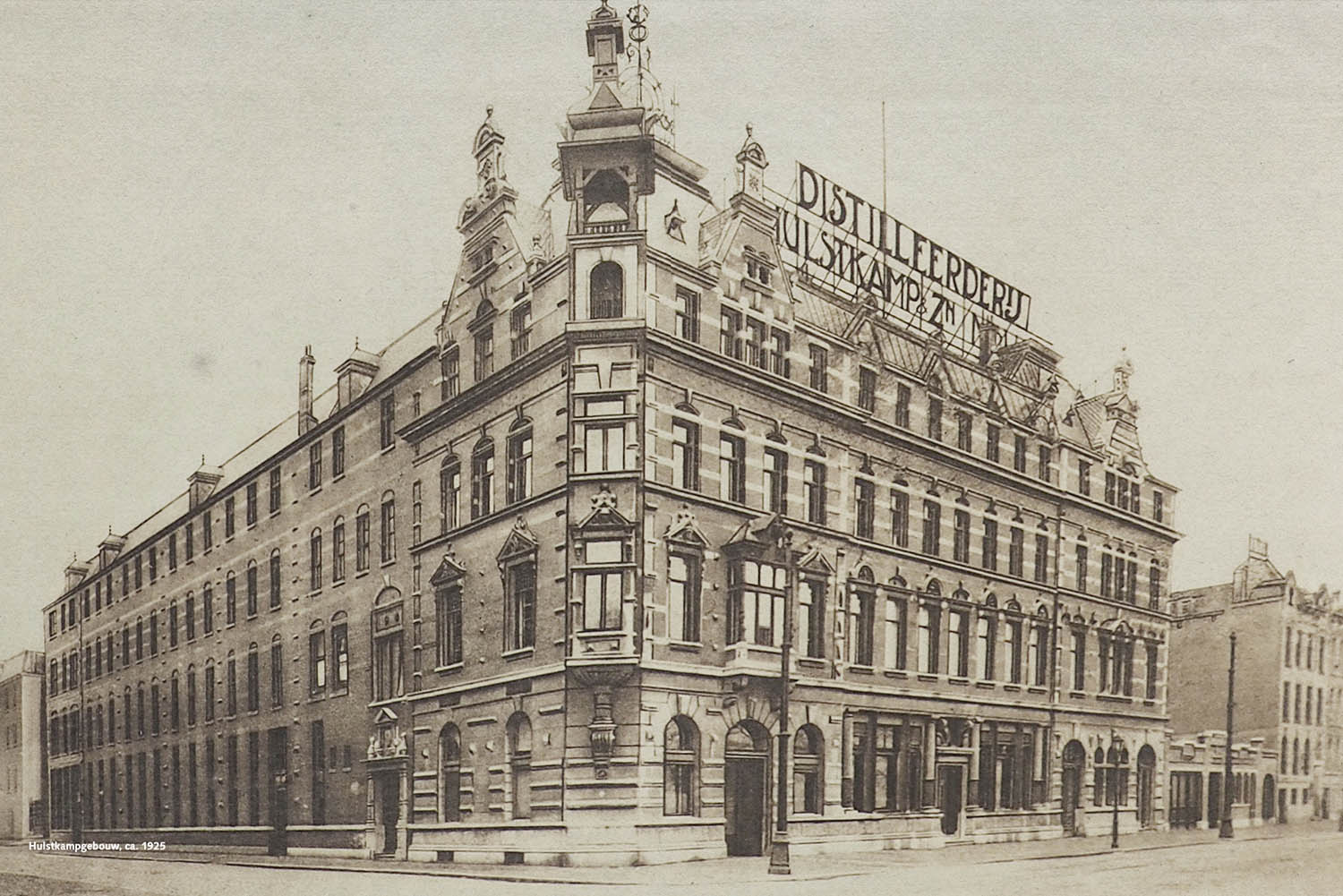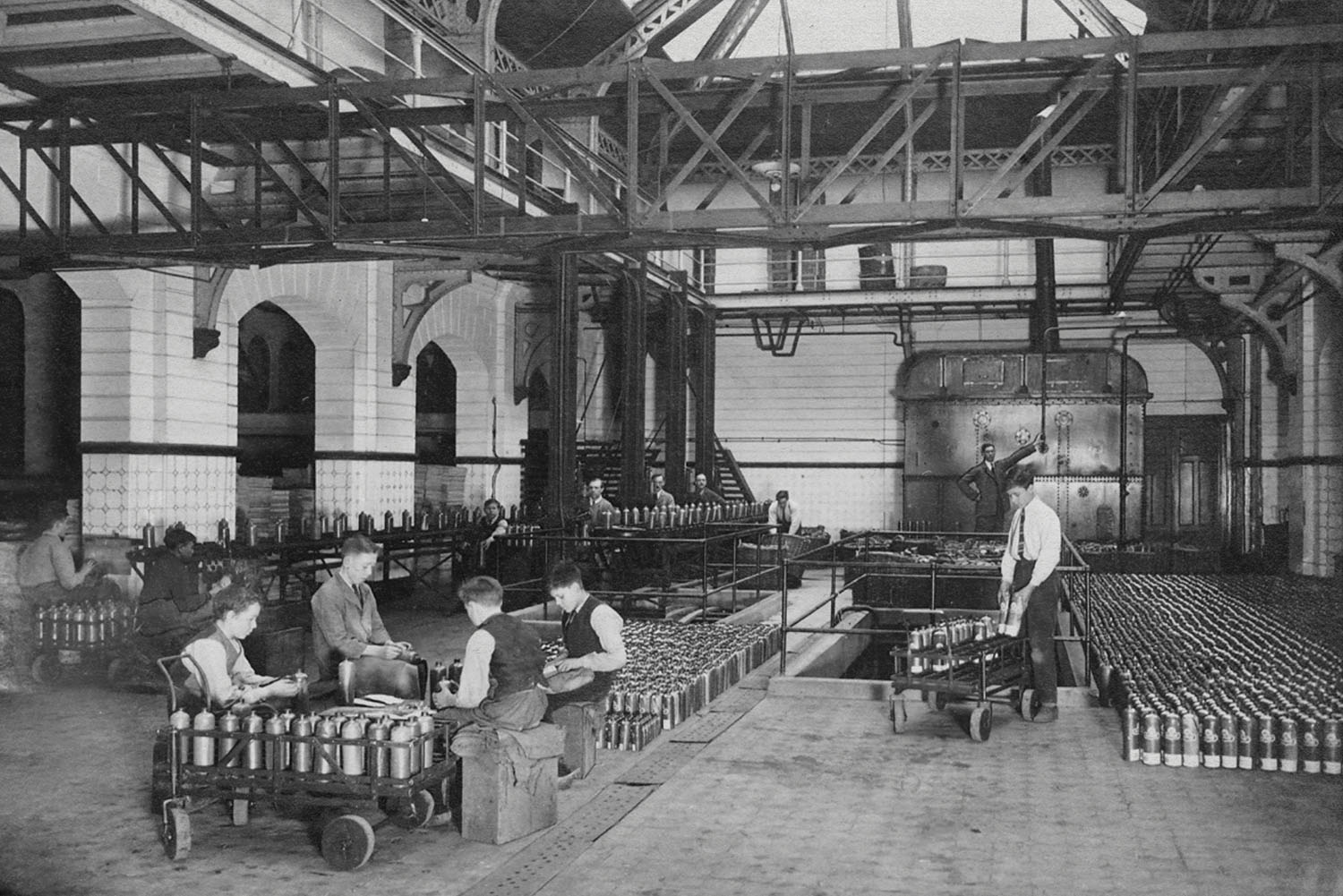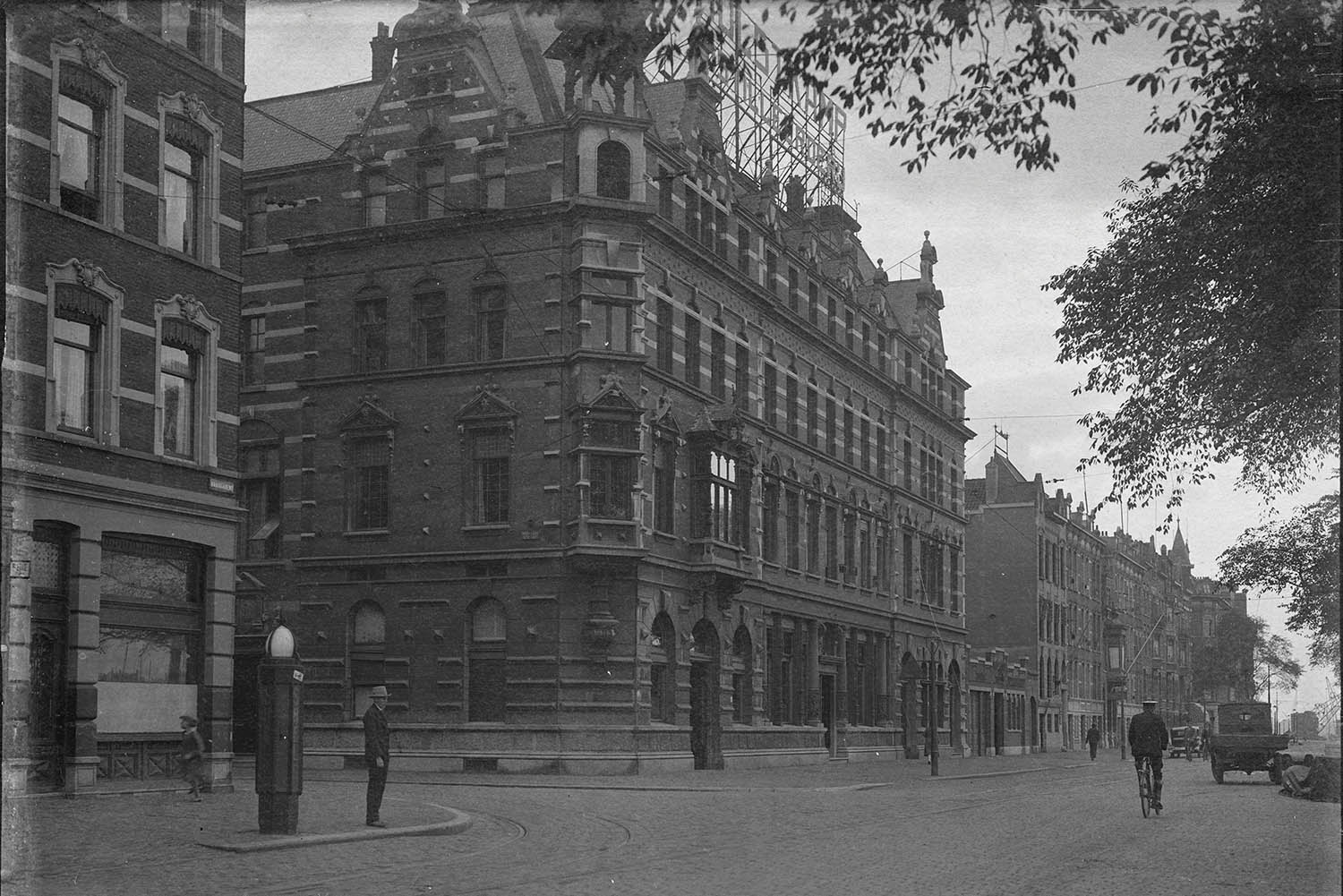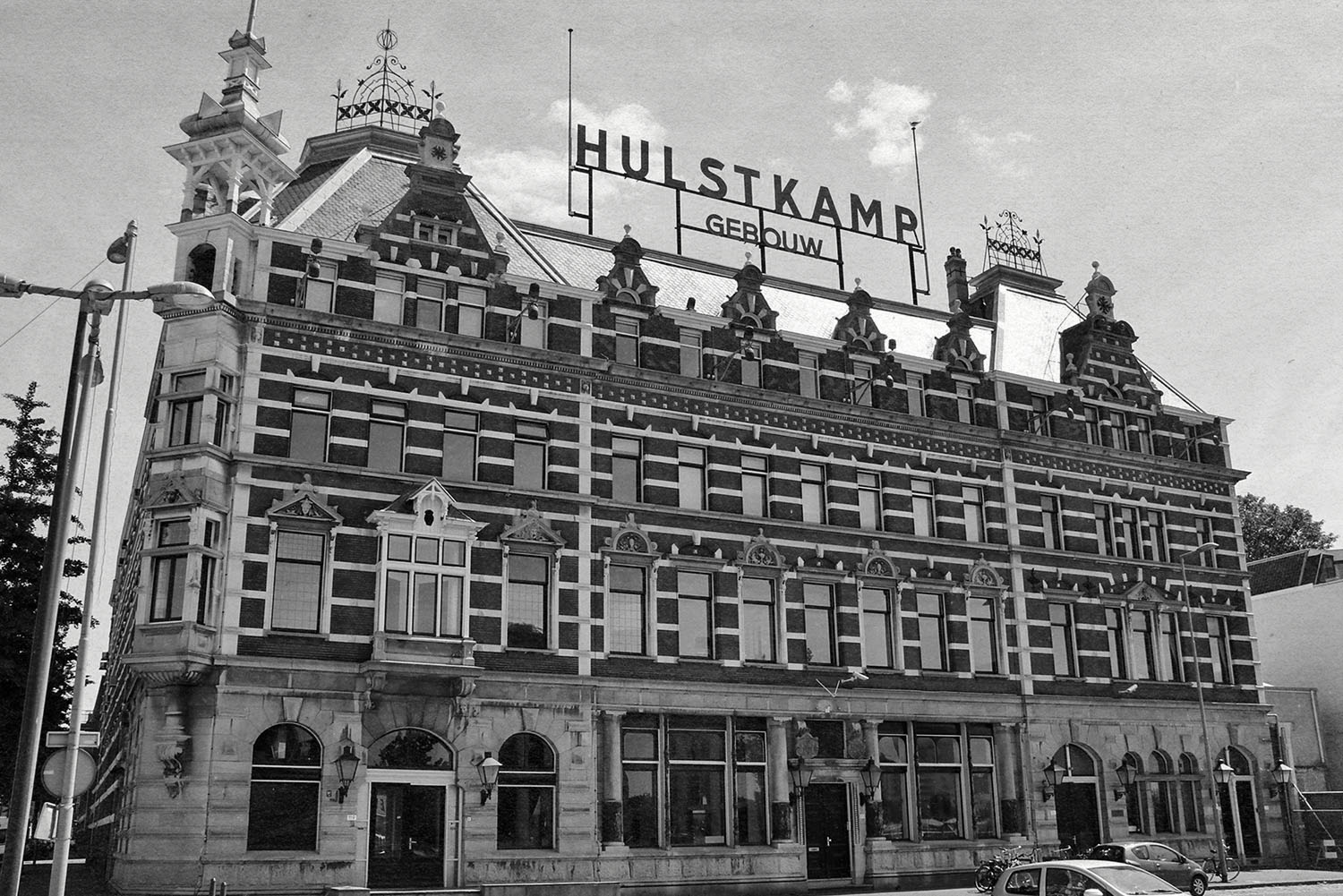1888 – 1892
Design and construction
On behalf of the firm Laming & Sons, the Rotterdam architect Jacobus Pieter Stok designed the Hulstkamp Building. He did so in the Dutch Neo-Renaissance style, following the fashion of his time. A typical stylistic feature is the combination of natural stone and red brickwork. The string courses, the horizontal white bands in the facade, are also characteristic of this style.


1892 – 1919
Margarine and cheese factory
After its construction, the Hulstkamp Building served as a margarine and cheese factory for the firm Laming & Sons. Apart from the large-scale production and storage areas, the management also wanted to include an office and a residence in the building. There was a factory section for the production of cheese and margarine, with a lot of space for cheese ripening in the warehouse. Additionally, the building was intended as the company’s headquarters and also served as the residence for the owner, J. Laming.
1919 – 1979
Jenever destillery
After the bankruptcy of the firm Laming & Sons, the Hulstkamp Building became the property of the firm Hulstkamp & Son & Molijn. This firm established a Jenever distillery in the building. Especially the warehouse part was ideal for the firm because the old jenever had to mature for a long time. It is thanks to the decades-long presence of the Hulstkamp firm that the building owes its name. In colloquial terms, the building became known as the “Hulstkampgebouw”. The firm conducted its activities in the building complex until 1978, when the company was taken over by the Amsterdam-based competitor Bols.

1940
Bombardment of Rotterdam
During the bombings of Rotterdam in May 1940, the Noordereiland was largely spared. The Germans had annexed the Noordereiland, after which they immediately occupied the Hulstkamp Building. Ultimately, only the two points of the island were hit, resulting in the loss of about 600 homes. These were English bombings, intended to isolate the Germans by targeting the Maas bridges. The Hulstkamp Building remained completely intact throughout the war.
1979
Renovation of the building
In 1979, the Hulstkamp Building was purchased by the Rotterdam developer Tom Westermeijer. He aimed to establish an office and congress center in the Hulstkamp Building. This led to a radical transformation of the interior. The warehouse, the covered courtyard, and the two factory halls were given an elegant styling. The original industrial character of these interiors was obliterated with an unrelenting whitewash. The covered courtyard became the ‘Wintertuin’, the concrete floor slabs were replaced with natural stone with paneling, and the storage spaces on the first, second, and third floors around the courtyard were transformed into office space. Due to the economic crisis and the high renovation costs, Mr. Westermeijer’s real estate company encountered financial difficulties, and all his prestigious projects in Rotterdam were forced to be sold to the Westland Utrecht Hypotheekbank.

1980 – 1995
Marine museum Rotterdam
After the building stood vacant, the Marine Museum was established there for a period of 15 years. The museum exhibits a collection related to the origin and history of the Marine Corps, the elite unit of the Royal Netherlands Navy. During this period, in 1984, the Hulstkamp Building was sold to the Thon Group, the real estate company of the Norwegian billionaire Olav Thon.
1995 – heden
Business center combined with event venue
After the renovation of the office building and the demolition of the distillery, the monumental building became a business center combined with a party and congress center, operated by Maison van den Boer. In 2021, this was taken over by Hutten Catering.
2000
National monument status
The Hulstkamp Building, with it’s height, width, and depth, stands as a unique exception in the otherwise uniform and relatively homogeneous facade along the Maaskade. The building owes it’s fame primarily to the monumental facade facing the Maaskade. As a result, the building has become one of the most well-known and iconic buildings in Rotterdam from the pre-war period. Partly for this reason, the Hulstkamp Building was granted national monument status in the year 2000.

1888 – 1892
Ontwerp en bOuw
In opdracht van de firma Laming & Zonen ontwierp de Rotterdamse architect Jacobus Pieter Stok het Hulstkamp Gebouw. Dat deed hij in de Hollandse Neorenaissancestijl, waarmee hij de mode van zijn tijd volgde. Een typisch stijlkenmerk is de combinatie van natuursteen en rood metselwerk. Ook de cordons, de horizontale witte banden in de gevel, zijn een kenmerk van deze stijl.

1892 – 1919
Margarine- en kaasfabriek
Na de bouw diende het Hulstkamp Gebouw als margarine- en kaasfabriek voor de firma Laming & Zonen. Los van de grootschalige productie- en opslagruimten, wilde de directie ook graag een kantoor en woonhuis in het pand. Zo was er enerzijds een fabrieksgedeelte voor de productie van kaas en margarine en was er veel ruimte voor de rijping van de kaas in het pakhuis. Anderzijds was het gebouw bestemd als hoofdkwartier van het bedrijf en deed het eveneens dienst als woonhuis voor de eigenaar J. Laming.

1919 – 1979
Jenever distilleerderij
Na het faillissement van de firma Laming & Zonen werd het Hulstkamp Gebouw eigendom van de firma Hulstkamp & Zoon & Molijn. Deze firma vestigde een jenever distilleerderij in het pand. Met name het pakhuis gedeelte was ideaal voor de firma omdat de oude jenevers lang moesten rijpen. Aan deze decennialange aanwezigheid van de firma Hulstkamp heeft het gebouw haar naam te danken. In de volksmond werd het gebouw dan ook bekend als het “Hulstkampgebouw”. De firma verrichtte tot aan 1978 haar activiteiten in het gebouwencomplex, waarna het bedrijf in hetzelfde jaar werd overgenomen door de Amsterdamse concurrent Bols.

1940
Bombardement Rotterdam
Bij de bombardementen op Rotterdam in mei 1940 werd het Noordereiland grotendeels ontzien. De Duitsers hadden het Noordereiland geannexeerd, waarna ze het Hulstkamp Gebouw direct bezetten. Uiteindelijk zijn alleen de twee punten van het eiland getroffen, waarbij er zo’n 600 woningen verloren zijn gegaan. Dit waren Engelse bombardementen, bedoeld om de Duitsers te isoleren door de Maasbruggen te treffen. Het Hulstkamp Gebouw bleef gedurende de oorlog verder geheel intact.
1979
Verbouwingen in het pand
In 1979 werd het Hulstkamp Gebouw gekocht door de Rotterdamse ontwikkelaar Tom Westermeijer. Hij wilde graag een kantoren- en congrescentrum tot stand brengen in het Hulstkamp Gebouw. Dit zorgde voor een rigoureuze metamorfose aan het interieur. Het pakhuis, de overdekte binnenplaats en de twee fabriekshallen kregen een quasi-chique styling. De oorspronkelijke industriële karakter van deze interieurs werden met een nietsontziende witkwast weggepoetst. De overdekte binnenplaats werd een ‘wintertuin’, de betonnen vloerplaten werden vervangen door natuursteen met lambriseringen en de opslagruimten op de eerste, tweede en derde verdieping rondom de binnenplaats, werden getransformeerd tot kantoorruimte. Door de economische crisis en de hoge renovatiekosten raakte het vastgoedbedrijf van dhr. Westermeijer in financiële moeilijkheden en werden al zijn Rotterdamse prestigeprojecten noodgedwongen verkocht aan de Westland Utrecht Hypotheekbank.
1980 – 1995
Mariniersmuseum Rotterdam
Na leegstand van het pand werd het Mariniersmuseum er voor een periode van 15 jaar in gevestigd. In het museum is een collectie tentoongesteld met betrekking tot het ontstaan en de geschiedenis van het Korps Mariniers, het eliteonderdeel van de Koninklijke Marine. (Sinds december 1995 is het museum gevestigd aan de Wijnhaven.) Tijdens deze periode werd het Hulstkamp Gebouw in 1984 doorverkocht aan de Thon-groep, het vastgoedbedrijf van de Noorse Miljardair Olav Thon.

1995 – heden
BedrijfsverzamelgebOuw annex evenementenlOcatie
Na de grondige renovatie van het kantoorgebouw en de sloop van de distilleerderij werd het monumentale pand een bedrijfsverzamelgebouw annex feest- en congrescentrum dat werd geëxploiteerd door Maison van den Boer. In 2021 is dit overgenomen door Hutten Catering.
2000
Status RijksmOnument
Na de grondige renovatie van het kantoorgebouw en de sloop van de distilleerderij werd het monumentale pand een bedrijfsverzamelgebouw annex feest- en congrescentrum dat werd geëxploiteerd door Maison van den Boer. In 2021 is dit overgenomen door Hutten Catering.
